Lecture
For distributed memory systems, MPI — the Message Passing Interface — is widely used.
Others are used: PMV (Parallel Virtual Machine) or SHMEM.
MPI is based on the message passing mechanism.
MPI is a common medium for creating and executing parallel programs.
Message passing
Method of transferring data from the memory of one processor to the memory of another
Data sent as packets
The message may consist of one or several packets.
Packages usually contain routing and management information
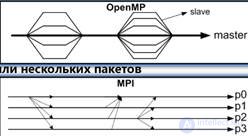
Process :
Set of executable commands (program)
The processor can run one or more processes.
Processes exchange information only via messages.
To improve performance, it is desirable to run each process on a separate processor.
On a multi-core PC, processes can be performed on separate cores.
Message PassingLibrary
Collection of functions used by the program
Designed to send, receive and process messages
Environment of parallel program execution

Send / receive
In the transmission of data, the interaction of two processors, the transmitter and receiver, is required.
Transmitter determines data position, size, type, receiver
Receiver must match the transmitted data.
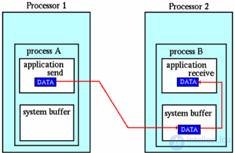
Synchronous / Asynchronous
The synchronous transfer is completed only after the receiver confirms receipt of the message.
Asynchronous transfer is performed without quitt (less reliably)
Applicationbuffer
Address space containing data to be transmitted or received (for example, a data memory area storing some variable)
Systembuffer
System memory for storing messages
Depending on the type of message, the data from the ApplicationBuffer can be copied to the SystemBuffer and vice versa.
BlockingCommunication
The function is completed only after some event
Non-blocking Communication
The function is completed without waiting for any communication events.
Using the system buffer after performing a non-blocking transfer operation DANGER!
CommunicatorsandGroups
Special objects that determine which processes can exchange data.
Process may be part of a group.
The group communicates using the communicator
Within the group, the process gets a unique number (identifiers)
Process can belong to several groups (different identifiers!)
Messages sent in different communicators do not interfere with each other
Supports 2 programming styles:
MIMD -MultipleInstructionsMultipleData
• Processes execute different program code
• It is very difficult to write and debug.
• Difficult to synchronize and manage the interaction of processes
SPMD -SingleProgramMultipleData
• The most common option
• All processes run the same software code.
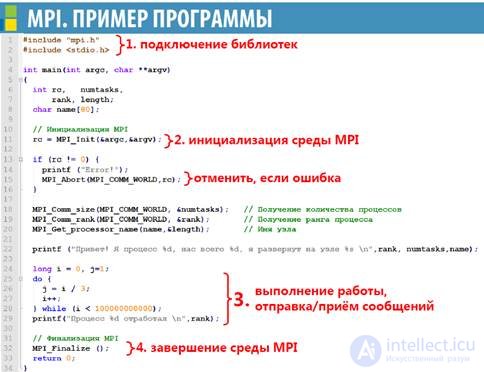
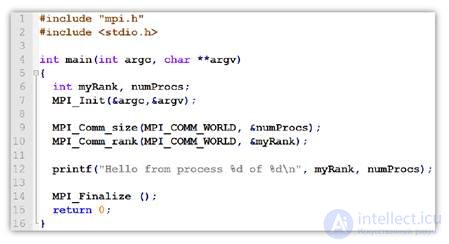
MPI is both a collection of libraries and a runtime environment.
Compiling and linking with mpicc script
mpiccMPI_Hello.co MPI_Hello
Run the program for execution using 5 processes
mpiexec-n 5 MPI_Helloс
Adding host addresses is done with the parameters “-hosts”, “-nodes”, “-hostfile”:
mpiexec – hosts 10.2.12.5 10.2.12.6
MPI feature set for data exchange between process groups
Features:
in the reception-transfer mode all processes work
The collective function works simultaneously on reception and transmission.
values of all parameters in all processes (except the buffer address) must match
Include:
MPI_Bcast () - message broadcast
MPI_SCATTER () - distribution of data to different processes
MPI_Gather () - collecting data from all processes into one process
MPI_Allgather () - collecting data from all processes in all processes
intMPI_Barrier () - point sync
MPI_Bcast (* buffer, count, datatype, root, comm)
buffer data buffer
count - data transfer counter
datatype data type
root - data source process
comm-communicator
MPI_Barrier ( comm )
Suspends the process until the moment when all group processes do not reach the barrier (synchronization point)
Processes are waiting for each other.
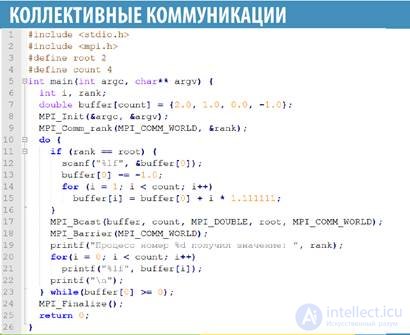
MPI_Scatter (* sendbuf, sendcnt, sendtype, * recvbuf, recvcnt, recvtype, root, comm)
Transfers data from the source process array to all process drives
sendbuf-buffer source with an array of broadcast data
sendcnt-data transfer counter
sendtype data type
recvbuf-receive buffer
recvcnt-received data counter
recvtype type of received data
root-number of the process sending the data
comm-communicator
MPI_Gather (* sendbuf, sendcnt, sendtype, * recvbuf, recvcnt, recvtype, root, comm)
Collects data from the buffers of all processes in the accumulator of the collector process.
sendbuf-buffer source of broadcast data
sendcnt-data transfer counter
sendtype data type
recvbuf-receive buffer for data collection
recvcnt-received data counter
recvtype type of received data
root-collecting process number
comm-communicator
MPI function set for exchanging data between separate processes
One branch calls the transfer function and the other the receive function.
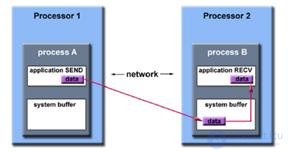
The bottom line:
Task 1 transmits:
intbuf [10];
MPI_Send (buf, 5, MPI_INT, 1, 0, MPI_COMM_WORLD);
Task 2 accepts:
intbuf [10];
MPI_Statusstatus;
MPI_Recv (buf, 10, MPI_INT, 0, 0,
MPI_COMM_WORLD, & status);
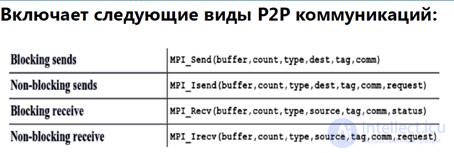
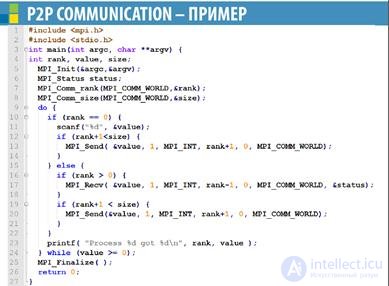

Create an application from N processes
Create and fill with a large array of data in the process 0
Transfer the part of the array to each process
In each process, we will sort the local array in ascending order.
In process 0, copy the local array to the output array
In process 0, in turn, we take local arrays from other processes and merge with the output array
Secondary functions:
• Buffer creation and filling with numbers
• Sort ascending specified buffer
• Print buffer items in the terminal window
• Merge two ordered arrays in ascending order
Функций Function Prototypes
double * generate1 (int);
double * processIt1 (double *, int);
voidshowIt1 (double *, int);
double * merge (double * arr1, double * arr2, intl1, intl2);
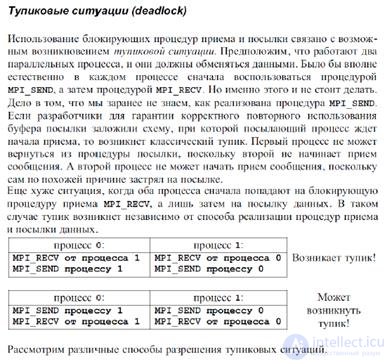

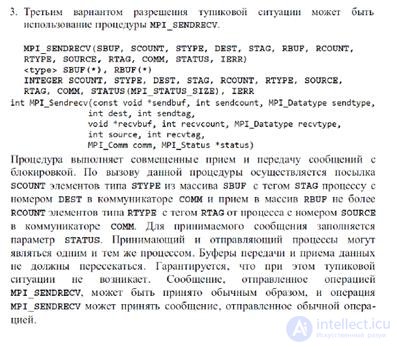
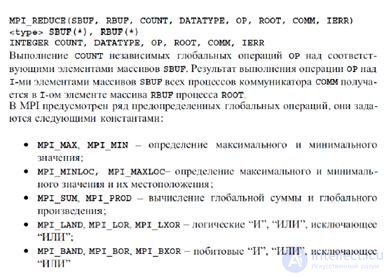
Comments
To leave a comment
Highly loaded projects. Theory of parallel computing. Supercomputers. Distributed systems
Terms: Highly loaded projects. Theory of parallel computing. Supercomputers. Distributed systems